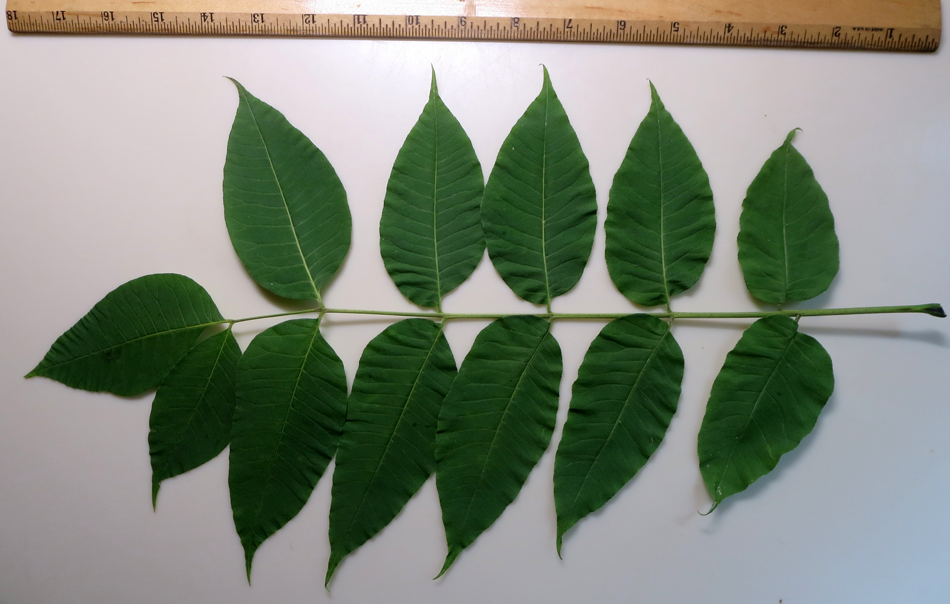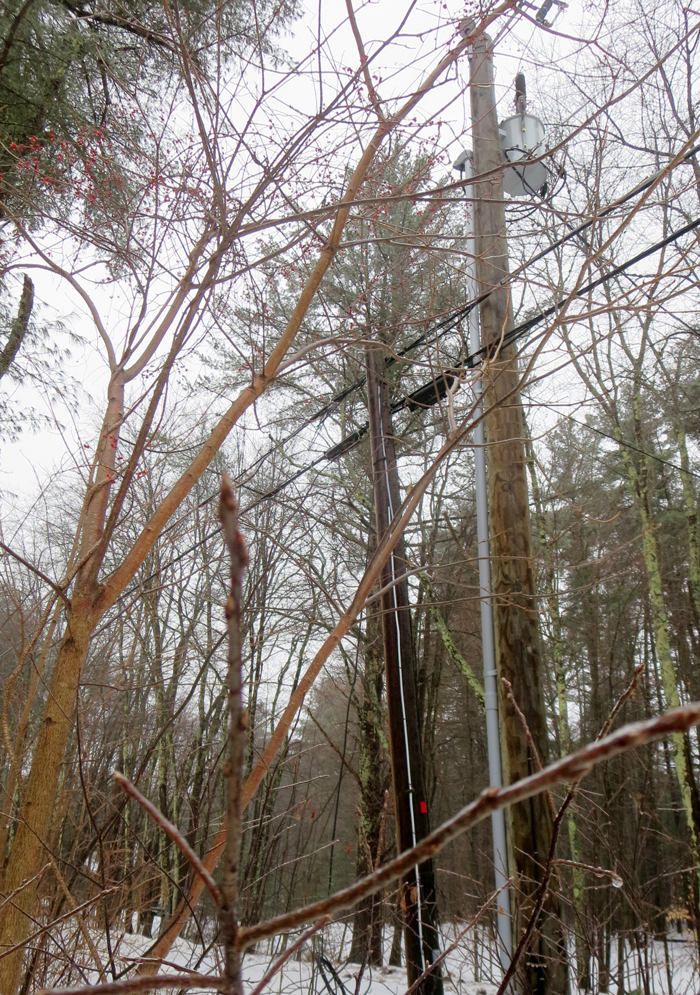Citizen Scientist: Sleuthing Out the Mystery of a New Invasive
Citizen Scientist: “generally refers to nonscientists contributing to scientific research”1
As Hillsborough County Coordinator for the NH Big Tree Program, I am always on the lookout for not only big trees, but also unusual and invasive trees. At an NRS training, I was alerted to the increasing problem of the invasive tree of heaven (Ailanthus altissima) that attracts a damaging invasive insect, the lantern bug. So when I spied a tree sprout with huge compound leaves growing in a roadside thicket near my house, I stopped to look. It was exploding with compound leaves that were over two feet long and lined with up to eight leaflets on each side.

I had already spotted this sun-loving tree growing along Route 293 in Manchester and was aware that it quickly consumes landscapes. I sure didn’t want it in my neighborhood, so I was alarmed when I saw these suspicious trees. I took photos and sent them to the UNH experts. The replies were cautious; how about the required notch at the base of the leaflets? No notches. Fall came and the leaves dropped. Later in the winter I saw clusters of stems from flowers or fruit all over the trees – a clue to pursue next season.
Feeling like Sherlock Holmes or a ‘Citizen Scientist,’ I was eager for spring to arrive to figure out what kind of tree I had found. But when the trees finally leafed out, I didn’t see my mystery trees. Did I imagine the whole thing? Or did I get tricked by the nearby shrub that also has long compound leaves – poison sumac, which I easily recognized after my experience of picking a leaf and getting the itchy rash. I was relieved when I later discovered it growing over my head – I didn’t think to look up! The compound leaves still did not have the required notch or teeth at the base of the leaflets, so it was definitely not the tree of heaven. But like the tree of heaven, it was a fast-growing plant. I checked Google Maps for their roadside views of the site. Luckily it was an old 2013 view, and amazingly, it showed a little 2 - 3 foot tall sapling with compound leaves at this location – the mystery tree as a sapling!
I continued to monitor through the summer and was astonished when in July I discovered the lower branches loaded with clumps of green berries. Now the winter stems made sense, but certainly I had never seen nor heard about large clusters of berries growing on trees.
I sent more photos off to the experts, and got questions about the leaf scars, the color of the stem when the bark was peeled back and the odor of the crushed leaves. After winter the leaf scars were barely visible, there was maybe some yellow under the bark, and maybe an odor. Ethan Belair, former Hillsborough County Forester specializing in invasive plants, and Emma Erler, Education Center Program Coordinator finally got it! Both suspected it to be the exotic amur corktree, Phellodendron amurense.
There is one on the UNH Durham campus that Emma was familiar with. The tree was brought to America in 1856 from China and Japan and planted in city parks, college campuses and Botanic Gardens like Arnold Arboretum, where a male tree was planted in 1875. Peculiarly, amur corktree is dioecious, with male and female parts on separate trees. The Arboretum tree did not produce seeds, so they had no indication that it might be an invasive problem. How astonishing to find it growing in the wild far from any known seed producing trees. I felt like a real Citizen Scientist!
Ethan promptly came to the site to verify these curious and potentially invasive trees. We confirmed them as amur corktrees, and walked about the neighborhood to find the parent tree. We thought we had found it, but a closer look revealed a nice black walnut tree whose compound leaves have serrated leaflets that are thinner and more pointed than the smoothed edged, fatter leaflets of the corktree.
How did these exotic young trees get to Amherst? Since the roadside power lines are nearby, birds seem to be the answer. Oriental bittersweet is wrapping itself around one of the trees confirming that birds do sit on the wires and spread seeds.

gather. Photo by Anne Krantz.
Is it a desirable tree? No!! Like so many exotic trees it has alarming attributes; its broad flat canopy shades out native tree saplings. It is already listed as an invasive tree in five states, including NH border state, Massachusetts.
Like all invasive plants, Amur corktree is very difficult and costly to get rid of once it escapes into the wild. It begins to produce seeds at a young age, shown by my neighborhood tree that was loaded with berries and seeds. Birds spread them by eating the berries, and the seeds are viable in the soil for several years. (I tried to count the seeds in a clump – about 75 x 6= 450 seeds per clump x a guessof 50 clumps = 22500 possible seeds!!) Cut stumps also sprout easily and prolifically, and that makes it hard to destroy.

seed cases with a tiny seed inside.
Photo by Anne Krantz.
The other known Amur corktree trees in NH are in Exeter and in Cornish on private property. If anyone thinks they have really found one after examining the leaves and scraping the bark to expose the neon yellow inner bark, please report it to through the EDDMapS (Early Detection and Distribution Mapping System) https://www.eddmaps.org/distribution/viewmap.cfm?sub=11569. They have a phone app too: EDDMapS Pro which is very helpful and allows you to report an invasive plant while you are looking at it. For reporting any invasive insects in NH, please report those to the webpage NHBugs.org.
1 https://nature.berkeley.edu/breakthroughs/sites/edu.breakthroughs/files/Breakthroughs_spring19_0.pdf
For more on invasive plants, see: https://www.invasiveplantatlas.org/subject.html?sub=11569
For more information about the corktree and its removal, see: https://ag.purdue.edu/facai/wp-content/uploads/2019/05/Capstone-Project_invasive.pdf.
For more information on becoming a Citizen Scientist, go to https://extension.unh.edu/topics/citizen-science

